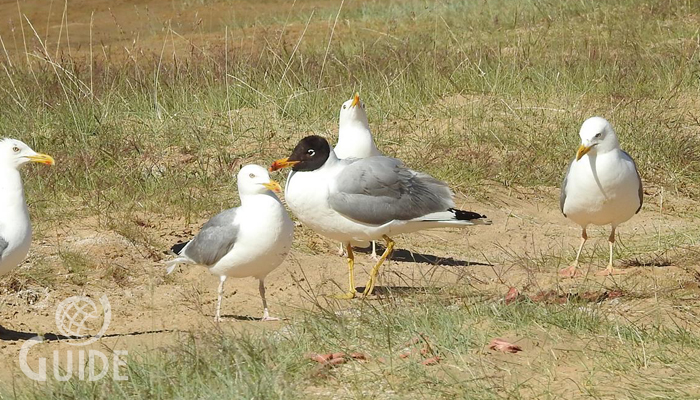
English: Great Black-headed Gull, Pallas’s Gull
Russian: Черноголовый хохотун
Mongolian: Итэлгэн цахлай
German: Fischmowe
French: Goeland ichthyaete
Japanese: オオズグロカモメ (O-zuguro-kamome)
Body length: 58-67 cm.
Wing span: 146-162 cm.
Is Obviously not a ‘large
white-headed gull’ but treated here for easy comparison due to its large size
and because non-adults have mainly whitish head. Nests colonially on marshes,
like islands etc. in SE Russia. Scarce
but regular in Middle East in winter; vagrant to Europe, with only one
record in Britain (in 1859), none in Ireland, but scattered genuine later
records in other W and C European countries, north to Sweden. Food fish,
crustaceans, insects (also swarming in flight), small mammals etc.
Identification: Four
age-groups, but plumage development initially quick as in a tree-year gull. As
large as or larger than Herring Gull. But slightly slimmer-bodied and
longer-winged, with elongated forehead which accentuates length and heaviness
of bill. In flight, slightly slimmer-winged than other large gulls, with deep
chest, long head, and large bill giving front-heavy look. Very large size and
black hood make adult summer unmistakable, but standing birds in other plumage
could easily be overlooked as Caspian Gulls, except for usually obvious dark
‘mask’ and white eye-crescents. Also, important always to bear in mind pitfall
of some other large gull with oil-stained head, thus essential to check other
diagnostic features described below, especially the distinctive wing and tail
patterns.
- Adult: Outer wing mainly white,
with black crescent across tip; black-banded yellowish bill (with red towards
tip in summer); and yellowish legs.
- Juvenile: Scaly brown above; brown breast-sides
or breast-band contrasting with white rest of underparts; striking pale grey midwing-panel;
underwing-coverts white; broad, clear-cut, black tail-band; pale dark-tipped
bill; and greyish or brownish-flesh legs.
- 1st winter/1st summer: As juvenile,
except adult-like pale grey upperparts, dark hindneck; bill and legs often show
some yellowish in 1st summer; 2nd year; Like adult, but much black on outer
wing, and thin black tail-band. 3rd
year: Like adult, but more black on wing-tip, and sometimes trace of tail-band.